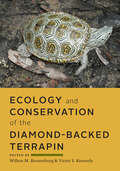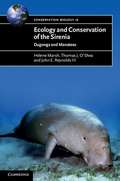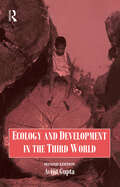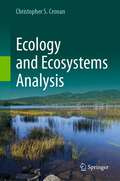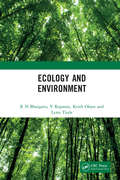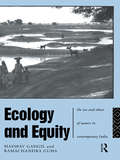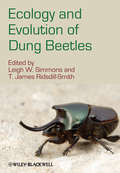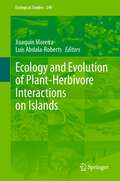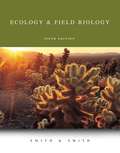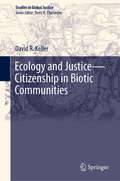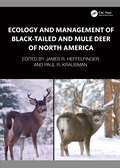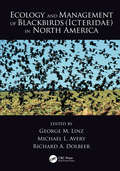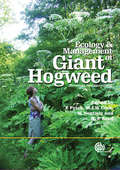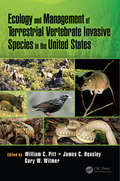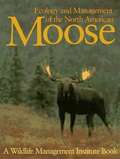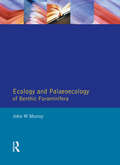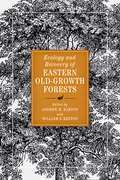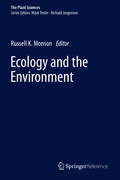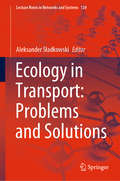- Table View
- List View
Ecology and Conservation of the Diamond-backed Terrapin
by Willem M. Roosenburg and Victor S. KennedyA fascinating look at the diamond-backed terrapin—an important, iconic, and imperiled American reptile.The diamond-backed terrapin is not only a uniquely evolved and beautiful turtle, it also has a long history as a vital American food source. Once so numerous that people reportedly grew tired of eating them, diamond-backed terrapins are greatly reduced in numbers today and have become an icon of salt marsh conservation. Considerably diminished in some areas and struggling to survive, this distinctive brackish water turtle is the focus of intense conservation efforts. In Ecology and Conservation of the Diamond-backed Terrapin, leading terrapin researcher Willem M. Roosenburg and experienced science editor Victor S. Kennedy have brought together a group of expert scientists to summarize our current understanding of terrapin biology, physiology, behavior, and conservation efforts. Over the course of 19 comprehensive chapters, contributors • review the latest information on this charismatic species • provide a detailed summary of the terrapin's natural history • explain the threats to terrapin population stability throughout their range• examine ongoing conservation efforts to ensure the reptile's survival• present convincing arguments for the value of the diamond-backed terrapin as an estuarine indicator organism• use the terrapin as a model for studying the consequences of exploitation and environmental degradation on long-lived speciesThis exceptional book provides pivotal information for estuarine and turtle biologists, terrapin enthusiasts, natural historians, educators, conservationists, resource managers, and students. Ecology and Conservation of the Diamond-backed Terrapin is the definitive volume on this important American reptile.Contributors: Benjamin K. Atkinson, Harold W. Avery, Patrick J. Baker, Ralph E.J. Boerner, Russell L. Burke, Joseph A. Butler, Randolph M. Chambers, Paul E. Converse, Brian A. Crawford, Rusty D. Day, Dana J. Ehret, J. Whitfield Gibbons, Kathryn M. Greene, Leigh Anne Harden, Andrew S. Harrison, Kristen M. Hart, George L. Heinrich, Dawn K. Holliday, Victor S. Kennedy, Shawn R. Kuchta, Lori A. Lester, Jeffrey E. Lovich, John C. Maerz, David Owens, Allen R. Place, Taylor Roberge, Willem M. Roosenburg, Richard A. Seigel, Amanda Southwood Williard, Edward A. Standora, Anton D. Tucker, Diane C. Tulipani, Timothy J. Walsh, Thane Wibbels, Will Williams, Roger C. Wood
Ecology and Conservation of the Maned Wolf: Multidisciplinary Perspectives
by Adriana G. Consorte-McCrea Eliana Ferraz SantosWolves are controversial figures worldwide and much effort has focused on how to conserve them while addressing public concerns. With its solitary habits and fruit-eating diet, the endangered maned wolf roams the South American grasslands and swamps, playing a vital part in maintaining biodiversity hotspots. In recent years, much effort has focused on the discussion of how to conserve large carnivores, such as wolves, while addressing public concerns. Gathering the work of leading researchers from diverse areas and countries, this book covers up-to-date research on the biology, ecology, and conservation of the maned wolf. It presents innovative insights that can benefit conservation strategies (in and ex situ health, feeding ecology, distribution, and people's attitudes) and offers diverse perspectives for the future of the species (education, human dimensions, ethnoconservation, and habitat studies).
Ecology and Conservation of the Sirenia: Dugongs and Manatees
by Thomas J. O'Shea Helene Marsh John E. Reynolds IIIDugongs and manatees, the only fully aquatic herbivorous mammals, live in the coastal waters, rivers and lakes of more than 80 subtropical and tropical countries. Symbols of fierce conservation battles, sirenian populations are threatened by multiple global problems. Providing comparative information on all four surviving species, this book synthesises the ecological and related knowledge pertinent to understanding the biology and conservation of the sirenia. It presents detailed scientific summaries, covering sirenian feeding biology; reproduction and population dynamics; behavioural ecology; habitat requirements and threats to their continued existence. Outlining the current conservation status of the sirenian taxa, this unique study will equip researchers and professionals with the scientific knowledge required to develop proactive, precautionary and achievable strategies to conserve dugongs and manatees. Supplementary material is available online at: www.cambridge.org/9780521888288.
Ecology and Development in the Third World (Routledge Introductions To Development Ser.)
by Avijit Gupta A. GuptaThis comprehensive second edition provides an up-to-date introduction to the nature of ecological degradation in a world of dramatic environmental change.
Ecology and Ecosystems Analysis
by Christopher S. CronanThe goal of this book is to convey the rich perspectives, principles, and enchantment of ecology to a broad audience of students and lifelong learners. The book is based on the belief that the science of ecology is best understood by examining familiar ecosystems from the natural world and weaving fresh insights and ecological concepts into an ecosystems framework to reveal the patterns, processes, and interactions that are the foundation of sustainable living systems in our biosphere. In the spirit of that teaching philosophy, the core of this book focuses on specific ecosystems that are familiar to most of us (e.g., forests, wetlands, streams, lakes, and the like).Taken as a whole, the chapters of this text are intended to provide a conceptual framework and an intellectual pathway for understanding and interpreting the ecology of the biosphere using elements of population, community, ecosystem, and landscape ecology. Equipped with this toolkit of ecological literacy, readers and students will hopefully be better prepared to make personal, business, and civic or governmental decisions that are consistent with a healthy and sustainable Earth.
Ecology and Environment
by R N Bhargava V Rajaram Keith Olson Lynn TiedeThe alarming rise in greenhouse gas and pollution level which has resulted in serious environmental and ecological harm is the biggest concern today. It has not only made the lives of mankind miserable but also threatens their very existence. Ecology and Environment has delved in depth on the subject and brings a broad perspective of the various issues. Following the curriculum of University Grants Commission, the book covers different types of ecosystem on the earth. It deals with the effective and sustainable use of natural resources which includes water, forest, mineral resources in the ground and productive land. The book explains the population trends in the world and India, and how it is impacting the environment. The role of public participation in promoting environmental sustainability is explored too. Please note: This volume is Co-published with The Energy and Resources Institute Press, New Delhi. Taylor & Francis does not sell or distribute the Hardback in India, Pakistan, Nepal, Bhutan, Bangladesh and Sri Lanka
Ecology and Equity: The Use and Abuse of Nature in Contemporary India (Oxford India Paperbacks Ser.)
by Ramachandra Guha Madhav GadgilEnvironmental destruction is seen a matter of worldwide concern but as a Third World problem. Ecology and Equity explores the most ecologically complex country in the world. India's peoples range from technocrats to hunter-gathers and its environments from dense forest to wasteland. The bookanalyses the use and abuse of nature on the sub-continent to reveal the interconnections of social and environmental conflict on the global scale. The authors argue that the root of this conflict is competition within different social groups and between different economic interests for natural resources. Radical both in its critique of the causes of crisis in India and in its proposals for ecological reform, Ecology and Equity is essential reading for all concerned for the Third World's in the world.
Ecology and Evolution of Dung Beetles
by Leigh W. Simmons T. James Ridsdill-SmithThis book describes the evolutionary and ecological consequences of reproductive competition for scarabaeine dung beetles. As well as giving us insight into the private lives of these fascinating creatures, this book shows how dung beetles can be used as model systems for improving our general understanding of broad evolutionary and ecological processes, and how they generate biological diversity. Over the last few decades we have begun to see further than ever before, with our research efforts yielding new information at all levels of analysis, from whole organism biology to genomics. This book brings together leading researchers who contribute chapters that integrate our current knowledge of phylogenetics and evolution, developmental biology, comparative morphology, physiology, behaviour, and population and community ecology. Dung beetle research is shedding light on the ultimate question of how best to document and conserve the world's biodiversity. The book will be of interest to established researchers, university teachers, research students, conservation biologists, and those wanting to know more about the dung beetle taxon.
Ecology and Evolution of Plant-Herbivore Interactions on Islands (Ecological Studies #249)
by Xoaquín Moreira Luis Abdala-RobertsTheory and early empirical work posed that herbivore pressure should be lower on islands than on the mainland owing to lower herbivore abundance and diversity in insular systems. Consequently, plant taxa found on islands are expected to be less protected or even to have lost their defences completely. While early observational studies supported the prediction of lower herbivory and plant defences on islands, recent island-mainland comparisons have yielded mixed results, with some studies finding no differences between islands and mainlands or, surprisingly, higher herbivory and plant defences on islands. In this book, the authors aim to re-assess current theory and initiate a new generation of work on insularity effects on plant-herbivore interactions. This book aims to fill the research gaps by integrating the research that has been done to date and by compiling and summarising new research on insularity effects on plant-herbivore interactions. It provides a critical examination of the patterns in light of classical theory and identifies potential mechanisms or underlying processes. It also aims to raise new questions that will form the basis for a revised and more robust research programme.
Ecology and Evolution of Rhizobia: Principles and Applications
by En Tao Wang Wen Feng Chen Chang Fu Tian Wen Xin Chen J. Peter YoungThis book reviews the history and development of rhizobial ecology (diversity, function and interactions with the biotic and abiotic environments), evolution (genome diversification, systematics of symbiotic genes) and application. Further, it describes the new concept of rhizobia, the latest systematic methods, biogeographic study methods, and genomic studies to identify the interactions between rhizobia, legumes and environments. To enable readers to gain a comprehensive understanding of rhizobial biogeography, the book provides effective protocols for the selection and application of high-efficiency rhizobial inoculants. In addition, it presents standard and modern methods used in studies on rhizobial ecology and evolution in dedicated appendices, making it a unique and valuable handbook for researchers.
Ecology and Field Biology (Sixth Edition)
by Robert Leo Smith Thomas M. SmithThis book presents a comprehensive overview of all aspects of ecology, including evolution, ecosystems theory, practical applications, plants, animals, biogeochemical cycles, and global change. A new chapter discusses global environmental change, human impacts on the global carbon cycle, and the possible implications for the global climate system. Six "Ecological Application Essays" demonstrate to students the real world relevance of ecological concepts. For example, Part V, Population Interactions, discusses how a lack of mushrooms helped power the Industrial Revolution. Reflecting current changes in the field of ecology, the new edition incorporates more discussion of the evolutionary perspective on ecological systems. For anyone interested in ecology.
Ecology and Justice—Citizenship in Biotic Communities (Studies in Global Justice #19)
by David R. KellerThis is the first book to outline a basic philosophy of ecology using the standard categories of academic philosophy: metaphysics, axiology, epistemology, aesthetics, ethics, and political philosophy. The problems of global justice invariably involve ecological factors. Yet the science of ecology is itself imbued with philosophical questions. Therefore, studies in ecological justice, the sub-discipline of global justice that relates to the interaction of human and natural systems, should be preceded by the study of the philosophy of ecology. This book enables the reader to access a philosophy of ecology and shows how this philosophy is inherently normative and provides tools for securing ecological justice. The moral philosophy of ecology directly addresses the root cause of ecological and environmental injustice: the violation of fundamental human rights caused by the inequitable distribution of the benefits (economies) and costs (diseconomies) of industrialism. Philosophy of ecology thus has implications for human rights, pollution, poverty, unequal access to resources, sustainability, consumerism, land use, biodiversity, industrialization, energy policy, and other issues of social and global justice. This book offers an historical and interdisciplinary exegesis. The analysis is situated in the context of the Western intellectual tradition, and includes great thinkers in the history of ecological thinking in the West from the natural sciences, social sciences and humanities. Keller asks the big questions and surveys answers with remarkable detail. Here is an insightful analysis of contemporary, classical, and ancient thought, alike in the ecological sciences, the humanities, and economics, the roots and fruits of our concepts of nature and of being in the world. Keller is unexcelled in bridging the is/ought gap, bridging nature and culture, and in celebrating the richness of life, its pattern, process, and creativity on our wonderland Earth. Holmes Rolston, III University Distinguished Professor, Colorado State UniversityAuthor of A New Environmental Ethics: The Next Millennium for Life on Earth (2012) Mentored by renowned ecologist Frank Golley and renowned philosopher Frederick Ferré, David Keller is well prepared to provide a deep history and a sweeping synthesis of the "idea of ecology"—including the metaphysical, epistemological, and ethical aspects of that idea, as well as the scientific. J. Baird Callicott University Distinguished Research Professor, University of North TexasAuthor of Thinking Like a Planet: The Land Ethic and the Earth Ethic (2013)
Ecology and Management of Black-tailed and Mule Deer of North America
by James R. Heffelfinger and Paul R. KrausmanBlack-tailed and mule deer represent one of the largest distributions of mammals in North America and are symbols of the wide-open American West. Each chapter in this book was authored by the world’s leading experts on that topic. Both editors, James R. Heffelfinger and Paul R. Krausman, are widely published in the popular and scientific press and recipients of the O. C. Wallmo Award, given every two years to a leading black-tailed and mule deer expert who has made significant contributions to the conservation of this species. In addition, Heffelfinger has chaired the Mule Deer Working Group sponsored by the Western Association of Fish and Wildlife Agencies for more than 15 years. This working group consists of the leading black-tailed and mule deer experts from each of 24 states, provinces, and territories in western North America, putting them at the forefront of all conservation and much of the research on this species. The book represents all current knowledge available on these deer, including how changing conditions such as fires, habitat alteration and loss, disease, climate change, socio-economic forces, energy development, and other aspects are influencing their distribution and abundance now and into the future. It takes a completely fresh look at all chapter topics. The revisions of distribution, taxonomy, evolution, behavior, and new and exciting work being done in deer nutrition, migration and movements, diseases, predation, and human dimensions are all assembled in this volume. This book will instantly become the foundation for the latest information and management strategies to be implemented on the ground by practitioners and to inform the public. Although this book is about deer, the topics discussed influence most terrestrial wildlife worldwide, and the basic concepts in many of the chapters are applicable to other species.
Ecology and Management of Blackbirds (Icteridae) in North America
by George M. Linz Michael L. Avery Richard A. DolbeerShortlisted for the 2018 TWS Wildlife Publication Awards in the edited book category The various species of new world blackbirds, often intermingled in large foraging flocks and nighttime roosts, collectively number in the hundreds of millions and are a dominant component of the natural and agricultural avifauna in North America today. Because of their abundance, conspicuous flocking behavior, and feeding habits, these species have often been in conflict with human endeavors. The pioneering publications on blackbirds were by F. E. L. Beal in 1900 and A. A. Allen in 1914. These seminal treatises laid the foundation for more than 1,000 descriptive and experimental studies on the life histories of blackbirds as well as their ecology and management in relation to agricultural damage and other conflicts such as caused by large winter roosting congregations. The wealth of information generated in over a century of research is found in disparate outlets that include government reports, conference proceedings, peer-reviewed journals, monographs, and books. For the first time, Ecology and Management of Blackbirds (Icteridae) in North America summarizes and synthesizes this vast body of information on the biology and life histories of blackbirds and their conflicts with humans into a single volume for researchers, wildlife managers, agriculturists, disease biologists, ornithologists, policy makers, and the public. The book reviews the life histories of red-winged blackbirds, yellow-headed blackbirds, common grackles, and brown-headed cowbirds. It provides in-depth coverage of the functional roles of blackbirds in natural and agricultural ecosystems. In doing so, this authoritative reference promotes the development of improved science-based, integrated management strategies to address conflicts when resolutions are needed.
Ecology and Management of Forest Soils
by Richard Fisher Dan BinkleyForest soils are the foundation of the entire forest ecosystem and complex, long-term interactions between trees, soil animals, and the microbial community shape soils in was that are very distinct from agricultural soils. The composition, structure, and processes in forest soils at any given time reflect current conditions, as well as the legacies of decades (and even millennia) of interactions that shape each forest soil. Reciprocal interactions are fundamental; vegetation alters soil physical properties, which influence soil biology and chemistry, which in turn influence the growth and success of plants. These dynamic systems may be strongly influenced by intentional and unintentional management, ranging from fire to fertilization. Sustaining the long-term fertility of forest soils depends on insights about a diverse array of soil features and changes over space and time. Since the third edition of this successful book many new interests in forest soils and their management have arisen, including the role of forest soils in sequestering carbon, and how management influences rates of carbon accumulation. This edition also expands the consideration of how soils are sampled and characterized, and how tree species differ in their influence on soil development. Clearly structured throughout, the book opens with the origins of forest soil science and ends with the application of soil science principles to land management. This new edition provides:A completely revised and updated Fourth Edition of this classic textbook in the fieldA coherent overview of the major issues surrounding the ecology and management of forest soils Global in scope with coverage of soil types ranging from the tropical rainforest soils of Latin America to the boreal forest soils of SiberiaNew chapters on Management: Carbon sequestration; Evidence-based approaches and applications of geostatistics, GIS and taxonomiesA clear overview of each topic, informative examples/case studies, and an overall context for helping readers think clearly about forest soilsAn introduction to the literature of forest soil science and to the philosophy of forest soil science researchThis coherent overview of the major issues surrounding the ecology and management of forest soils will be particularly useful to students taking courses in soil science, forestry, agronomy, ecology, natural resource management, environmental management and conservation, as well as professionals in forestry dealing with the productivity of forests and functioning of watersheds.
Ecology and Management of Giant Hogweed
by P. Pysek M. J. W. Cock W. Nentwig H. P. RavnThis book is an authoritative compendium of current knowledge on this amazing invasive plant and will facilitate improved management. It is an invaluable resource for both practitioner and student, and covers topics including taxonomy, genetics, reproduction, population ecology, and invasion dynamics.
Ecology and Management of Terrestrial Vertebrate Invasive Species in the United States
by William C. Pitt James Beasley Gary W. WitmerVertebrate invasive species are important ecologically, socially, and scientifically throughout much of the globe. However, the interdiction and options for management of invasive species are driven by localized regulation at the country or even state level and thus the management of species must be framed within that context. This book is focused around the management of invasive vertebrate species in the United States, although readers will find much of the material broadly applicable to invasive species in other regions. Vertebrate invasive species cause damage to agriculture, property, natural resources, and threaten human health and safety. However, most of these species occur in the United States resulting from human-mediated activities, often being released intentionally. For the first time, the wealth of scientific information about vertebrate invasive species in the United States is summarized and synthesized in a single volume to be easily accessible to ecologists and natural resource managers. With a focus on prominent terrestrial invasive species that have a history of policy and management and highlighting contemporary issues and management, this book consists of 18 chapters written by experts from across the United States. The first section of the book focuses on overarching policy and management topics associated with vertebrate invasive species; including biosecurity threats and risk assessment, policy and regulation, and the economics of their management. The second section provides in-depth reviews of noteworthy invasive mammals, birds, amphibians, and reptiles. After finishing this book, the reader should understand the complexity of managing invasive species, the unique challenges that each new species may present, and the steps forward that may decrease the impact of these species on the environment, human health, and the economy.
Ecology and Management of the North American Moose (Zoo & Aquarium Biology & Conservation)
by Charles Schwartz Albert FranzmannThe largest of all living deer, moose in North America range across a broad band of forest and glade that extends from Newfoundland to the Rocky Mountains, into Alaska, and as far south as Colorado. Prized by Native Americans and incorporated into their cultures, moose also were hunted by successive waves of European settlers. Nearly eradicated by the turn of the century, the continent-wide population has rebounded to an estimated one million, and the moose has become a ubiquitous symbol of the untrammeled northern wilderness. <p><P> The most comprehensive book ever published on the North American moose, this abundantly illustrated volume fully explains moose biology and ecology and assesses the increasingly complex enterprise of managing the species. Twenty-one wildlife biologists and researchers discuss moose taxonomy, reproduction and growth, feeding habits, behavior, population dynamics, relationships with predators, incidental mortality, and seasonal migration patterns. They analyze the effect of new strategies of moose habitat and harvest management--including the planting of late-winter cover, hunting regulations, and aerial and ground-level tracking methods. They also describe immobilization, handling, and translocation practices and discuss the future of moose management. <p> Increasingly, both human and wildlife requirements must be taken into account when scheduling hunting seasons, setting moose population goals, devising strategies to divert moose from roads, or enhancing moose habitats. Written by many of the world's foremost authorities on the species, Ecology and Management of the North American Moose offers wildlife managers, biologists, researchers, mammalogists, hunters, photographers, and the conservation-minded public a wealth of timely information about the status, distribution, and natural and life histories of these fascinating mammals."
Ecology and Palaeoecology of Benthic Foraminifera
by John W. MurrayThis is an important and authoritative review of foraminiferal ecology, the first for over a decade. Professor Murray relates ecological data on living forms of foraminifera to the palaeoecology of fossil species, and defines in detail areas of global distribution.
Ecology and Recovery of Eastern Old-Growth Forests
by Andrew M. Barton William S. KeetonNorth American landscapes have been shaped by humans for millennia through fire, agriculture, and hunting. But the arrival of Europeans several centuries ago ushered in an era of rapid conversion of eastern forests to cities, farms, transportation networks, and second-growth woodlands. Recently, numerous remnants of old growth have been discovered, and scientists are developing strategies for their restoration that will foster biological diversity and reduce impacts of climate change. Forest ecologists William Keeton and Andrew Barton bring together an edited volume that breaks new ground in our understanding of eastern old-growth forest ecosystems and their importance for resilience in an age of rapid environmental change. Leading experts examine topics of contemporary forest ecology across a broad geographic canvas in the eastern United States.
Ecology and the Environment
by Russell K. MonsonIn this book, plant biology is considered from the perspective of plants and their surrounding environment, including both biotic and abiotic interactions. The intended audience is undergraduate students in the middle or final phases of their programs of study. Topics are developed to provide a rudimentary understanding of how plant-environment interactions span multiple spatiotemporal scales, and how this rudimentary knowledge can be applied to understand the causes of ecosystem vulnerabilities in the face of global climate change and expansion of natural resource use by human societies. In all chapters connections are made from smaller to larger scales of ecological organization, providing a foundation for understanding plant ecology. Where relevant, environmental threats to ecological systems are identified and future research needs are discussed. As future generations take on the responsibility for managing ecosystem goods and services, one of the most effective resources that can be passed on is accumulated knowledge of how organisms, populations, species, communities and ecosystems function and interact across scales of organization. This book is intended to provide some of that knowledge, and hopefully provide those generations with the ability to avoid some of the catastrophic environmental mistakes that prior generations have made. "
Ecology and the Environment: Interactive Science
by Michael J. Padilla Don Buckley Zipporah Miller Kathryn Thornton Michael E. WysessionThis Ecology and the Environment Interactive Science textbook contains chapters on Populations and Communities, Ecosystems and Biomes, Resources and Living Things, Land, Air, and Water Resources and Energy Resources.
Ecology and the Environment: Module C Grades 6-8 (2018 Edition) (HMH Science Dimensions)
by Marjorie Frank Michael R. Heithaus Michael A. DiSpezioNIMAC-sourced textbook
Ecology in Action
by Singer Fred D.Taking a fresh approach to integrating key concepts and research processes, this undergraduate textbook encourages students to develop an understanding of how ecologists raise and answer real-world questions. Four unique chapters describe the development and evolution of different research programs in each of ecology's core areas, showing students that research is undertaken by real people who are profoundly influenced by their social and political environments. Beginning with a case study to capture student interest, each chapter emphasizes the linkage between observations, ideas, questions, hypotheses, predictions, results, and conclusions. Discussion questions, integrated within the text, encourage active participation, and a range of end-of-chapter questions reinforce knowledge and encourage application of analytical and critical thinking skills to real ecological questions. Students are asked to analyze and interpret real data, with support from online tutorials demonstrating the R programming language for statistical analysis.
Ecology in Transport: Problems and Solutions (Lecture Notes in Networks and Systems #124)
by Aleksander SładkowskiThis book analyzes how transport influences the ecology of various regions. Integrating perspectives and approaches from around the globe, it examines the use of different types of engines and fuels, and assesses the impact of vehicle design on the environment. The book also addresses the effect of the transport situation in agglomerations on their environmental safety. Various types of environmental impacts are considered, from traditional emissions to noise and vibration. Presenting scientific advances from 7 European countries, the book appeals to experts, teachers and students, as well as to anyone interested in the environmental aspects of the transport industry.
